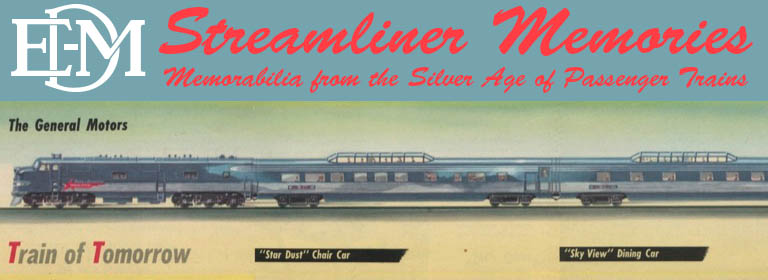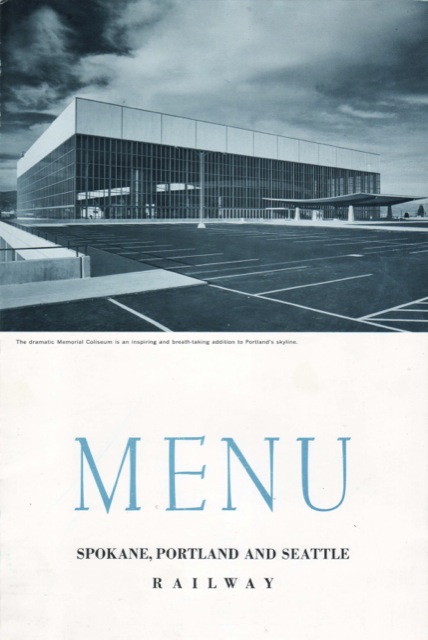This menu features a photo of Portland’s Memorial Coliseum on the front and a drawing of it on the back. Portland completed this coliseum in 1961 at a cost of $8 million ($62 million today). For about a decade, it hosted a minor league hockey team, various rock concerts (I sat in the front row listening to Frank Zappa in the only rock concert I ever attended), and auto, boat, and home shows. Eventually, the Portland Trailblazer basketball team made its home there, but its owner, Paul Allen, built a another arena a few blocks away that had some 60 percent more seats. Today, the Memorial Coliseum still exists mainly because the city doesn’t have the political will to tear it down.
Click image to download a 2.3-MB PDF of this menu.
The menu is pretty elaborate for a railroad that actually had few opportunities to serve people dinner. In 1965, it had two major passenger trains a day between Portland and Spokane, one of which connected with the North Coast Limited at Pasco and the Empire Builder in Spokane, while the other connected with the Mainstreeter in Pasco and the Western Star in Spokane. Of these, the only train that operated during the dinner hour was the eastbound connection with the North Coast Limited/Empire Builder. To serve this train, in 1947 the SP&S bought just one streamlined diner that shuttled back and forth between Portland and Spokane. It supplemented this in 1966 when it bought a former MKT diner.
Despite this, the menu had five entrées on the table d’hôte side: prime rib; salmon; Swiss steak; chicken a la king; and “steak,” presumably the same as the “broiled N.Y. cut steak” on the a la carte side. The a la carte side had nine other entrées, only two of which–the chicken and Swiss steak–were on the table d’hôte side. That meant the SP&S commissary had to provide the ingredients for a dozen different entrées for the patrons of just one train a day–quite a difference from Union Pacific menus that only had five entrées and no a la carte items (though the UP also had café cars offering a la carte service).
The most expensive item on the menu is the table d’hôte steak dinner, for $5.40 (about $40 today). The other table d’hôte entrées ranged from $3.50 to $4.10 (about $25 to $30 today). The differences in prices between the table d’hôte entrées and a la carte ones ranged from $1.65 for the steak to $1.95 for the Swiss steak. That’s a pretty good deal for hungry train riders considering that all the extras that come with a table d’hôte meal could add up to around $3.50.
The menu also offers “plate dinner no. 2” which was either “chef’s suggestion” or “ham or cheese omelet,” with potato, vegetable, bread, ice cream, and beverage, all for $2.60 (about $19 today).
Most railroad dining cars, including Amtrak, have had the unusual (for a restaurant) practice of requiring patrons to write down their orders and give them to the servers. I don’t know the history behind this; it is possible that early dining car crews were not expected to be literate. In any case, this particular menu added that patrons should “Place order by number and write selection on check.” This is peculiar because of the more than 75 items on the menu, the only one that has a number is “plate dinner no. 2.” Perhaps “place order by number” was another by-gone habit on SP&S diners, and the railroad forgot to remove this statement when it dropped the numbers.

